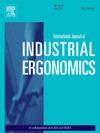Developing workload-informed crew configuration recommendations for emergency medical services
IF 3
2区 工程技术
Q2 ENGINEERING, INDUSTRIAL
International Journal of Industrial Ergonomics
Pub Date : 2025-07-01
DOI:10.1016/j.ergon.2025.103777
引用次数: 0
Abstract
While crew configuration in primary care settings has been studied in terms of its impact on patient outcomes, less is known about how it influences the members' workload experience. This study investigates the workload implications of crew configuration based on members' certification in emergency medical services (EMS). Advanced life support (ALS) ambulance crews are commonly comprised of two paramedics (homogeneous crew) or an emergency medical technician (EMT) and a paramedic (heterogeneous crew). The goals of this study were the following: (1) to investigate differences in workload among members of the same crew, and (2) to use workload assessments to inform crew configuration strategies. We mapped one year of an EMS system's dispatch data to members' workload estimates using the visual, auditory, cognitive, and psychomotor (VACP) approach. We found that lead members (lead paramedics) experience higher workload levels compared to support members (support paramedics or EMTs) in both types of crews. Neither configuration had a consistently lower workload than the other, but differences varied for different shifts and stations. These results informed crew configuration recommendations for stations and shifts in the collaborating system, and in terms of more generalizable variables. A minimum number of staffed crews, half-half shift type (covering both day and night hours), and 30-day frequency of calls with priority P7 most significantly impacted the recommended crew configurations.
为紧急医疗服务制定工作负荷知情的机组配置建议
虽然已经研究了初级保健机构的工作人员配置对患者结果的影响,但对其如何影响成员的工作量体验知之甚少。本研究旨在探讨紧急医疗服务中,基于成员资格认证的机组配置对工作量的影响。高级生命支持(ALS)救护人员通常由两名护理人员(同质人员)或一名紧急医疗技术人员(EMT)和一名护理人员(异质人员)组成。本研究的目的如下:(1)调查同一机组成员之间的工作量差异;(2)使用工作量评估来告知机组配置策略。我们使用视觉、听觉、认知和精神运动(VACP)方法将EMS系统一年的调度数据映射到成员的工作量估计。我们发现,在这两种类型的工作人员中,领导成员(领导护理人员)比支持成员(支持护理人员或emt)的工作量更高。两种配置都没有始终比另一种更低的工作量,但不同班次和站点的差异有所不同。这些结果为协作系统中站位和班次的机组人员配置建议提供了依据,并提供了更多可推广的变量。最小工作人员数量、半轮班类型(包括白天和夜间)以及优先级为P7的30天呼叫频率对建议的工作人员配置影响最大。
本文章由计算机程序翻译,如有差异,请以英文原文为准。
求助全文
约1分钟内获得全文
求助全文
来源期刊
CiteScore
6.40
自引率
12.90%
发文量
110
审稿时长
56 days
期刊介绍:
The journal publishes original contributions that add to our understanding of the role of humans in today systems and the interactions thereof with various system components. The journal typically covers the following areas: industrial and occupational ergonomics, design of systems, tools and equipment, human performance measurement and modeling, human productivity, humans in technologically complex systems, and safety. The focus of the articles includes basic theoretical advances, applications, case studies, new methodologies and procedures; and empirical studies.

 求助内容:
求助内容: 应助结果提醒方式:
应助结果提醒方式:


